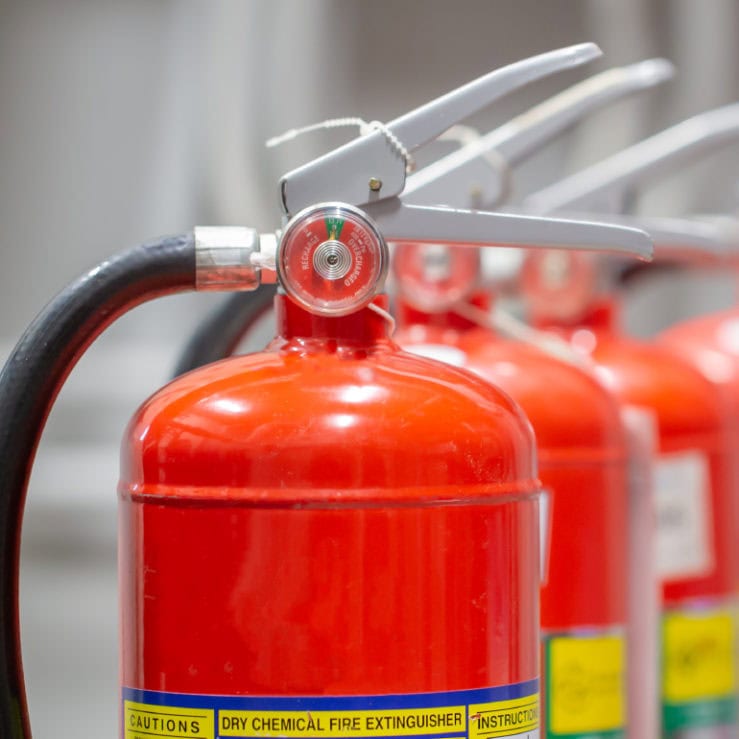Recent research shows that, over the course of a single year, over 4,000 fires in the UK required evacuation, with approximately 2,500 people needing to be rescued. Tragically, around 425 of these incidents proved fatal.
Fire risks in commercial premises vary depending on the nature of the business. However, the reality is that many commercial buildings are multi-tenancy and multi-use, so the overall fire risks are significantly higher.
Understanding how fires commonly start is essential to preventing them. Here’s a quick overview along with how we at Commercial Fire Protection can help safeguard your building, protect its occupants and assets, and support you in achieving vital fire safety compliance.
1. Flammable substances
Anything that can burn poses a fire risk – especially highly flammable materials and substances.
Commercial buildings often house a variety of these such as leaking gas, cleaning chemicals, solvents, paints, adhesives, and petroleum-based products commonly used in maintenance or operations. Equipment like welding tools or machinery with combustible fuels also adds to the risk.
Each one of these items is a potential flashpoint, and proper storage and safe handling of these flammable substances is critical to reducing fire risk and maintaining a safe environment.
2. Kitchen areas
Though often overlooked in commercial premises, kitchen areas can be significant fire hotspots.
Cooking appliances, such as ovens, microwaves, toasters and kettles, in the communal tea room or staff kitchen, present a major risk if left unattended or poorly maintained. In fact, cooking appliances are responsible for almost 45% of domestic fire incidents – a warning sign for businesses with similar set ups.
3. Electrical issues
Electrical systems are another leading cause of fire, responsible for approximately 15% of incidents. Faulty wiring, overloaded circuits, aging distribution systems, and damaged appliances or extension leads and plugs, are all preventable risks that demand regular inspection and maintenance.
Some 15% of fires are linked to faults in electrical distribution systems, Faulty electrical appliances – including cords and plugs in poor condition – also contribute heavily to fire incidents.
4. Smoking materials
Discarded cigarette ends and matches account for the highest fatality rate of any fire cause, at 35%! In commercial buildings, especially those with shared or outdoor smoking areas, the proper disposal and management of smoking materials is critical.
5. Proximity to Heat Sources
The terrible fire at Windsor Castle, caused by a hot lamp bulb being placed too close to a curtain, is a stark reminder of the dangers of placing flammable materials near heat sources. Around 15% of fires in the UK stem from similar issues. In commercial buildings, it is critical to ensure all heating appliances, lighting fixtures, and electrical equipment are safely positioned and regularly checked.
6. Dealing effectively with fire risk
Whilst prevention is always better than cure, dealing effectively with fire risk also involves putting measures in place to combat the spread and effects of fire should the worst happen.
These include Fire Strategy, Fire Emergency Evacuation Plans (FEEPs), and Fire Risk Assessments (FRAs)
These are not just legal obligations under the Regulatory Reform (Fire Safety) Act 2005, but essential tools in ensuring swift and safe evacuation. They must be bespoke to your building and regularly reviewed.
Fire compartmentation and fire door solutions
Fire compartmentation uses fire-resistant walls, floors, ceilings, partitions, and barriers to prevent the spread of fire and toxic gases. Together with fire door solutions, this contains the fire, keeping escape routes clear, and reducing damage to the building and assets.
How Commercial Fire Protection can help you
Collectively, these methods fall into the passive fire protection (PFP) category. Together with effective active fire protection, and carefully developed Fire Strategy, FEEPs, and FRAs, they form the backbone of every commercial building’s defences against fires, and provide safe means of escape, whatever their causes.
At Commercial Fire Protection, we have a skilled team with decades of fire protection experience and ‘gold standard’ BM Trada Q-Mark Scheme certifications.
As a certified fire protection company, we’re ready to advise you on all aspects of fire safety and deliver the work needed to keep your commercial building and its occupants protected, however fire starts.
Contact us today to find out more about how we can help you with these and many other fire protection requirements – and request your copy of our FREE Guide to Fire Protection Compliance here.




